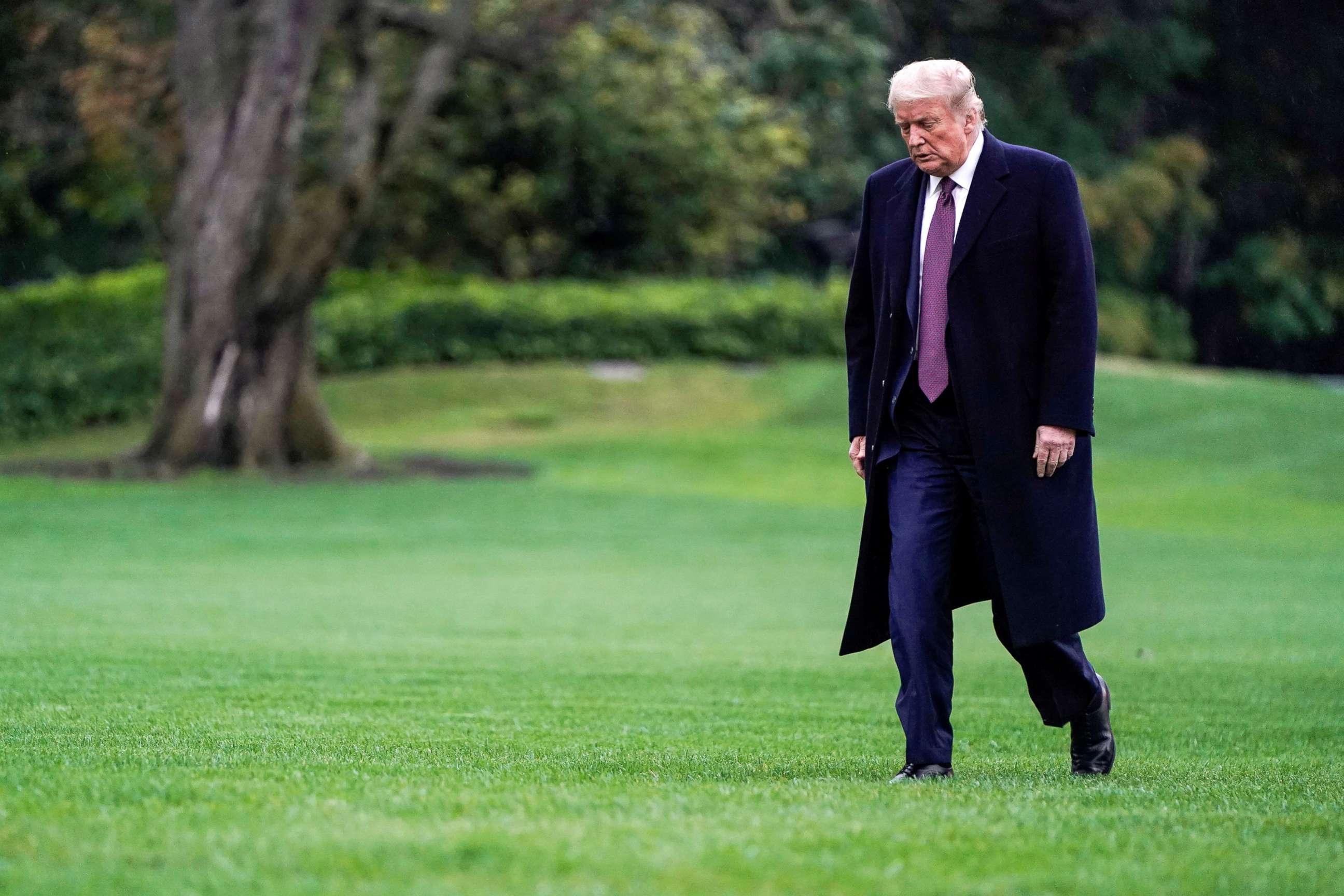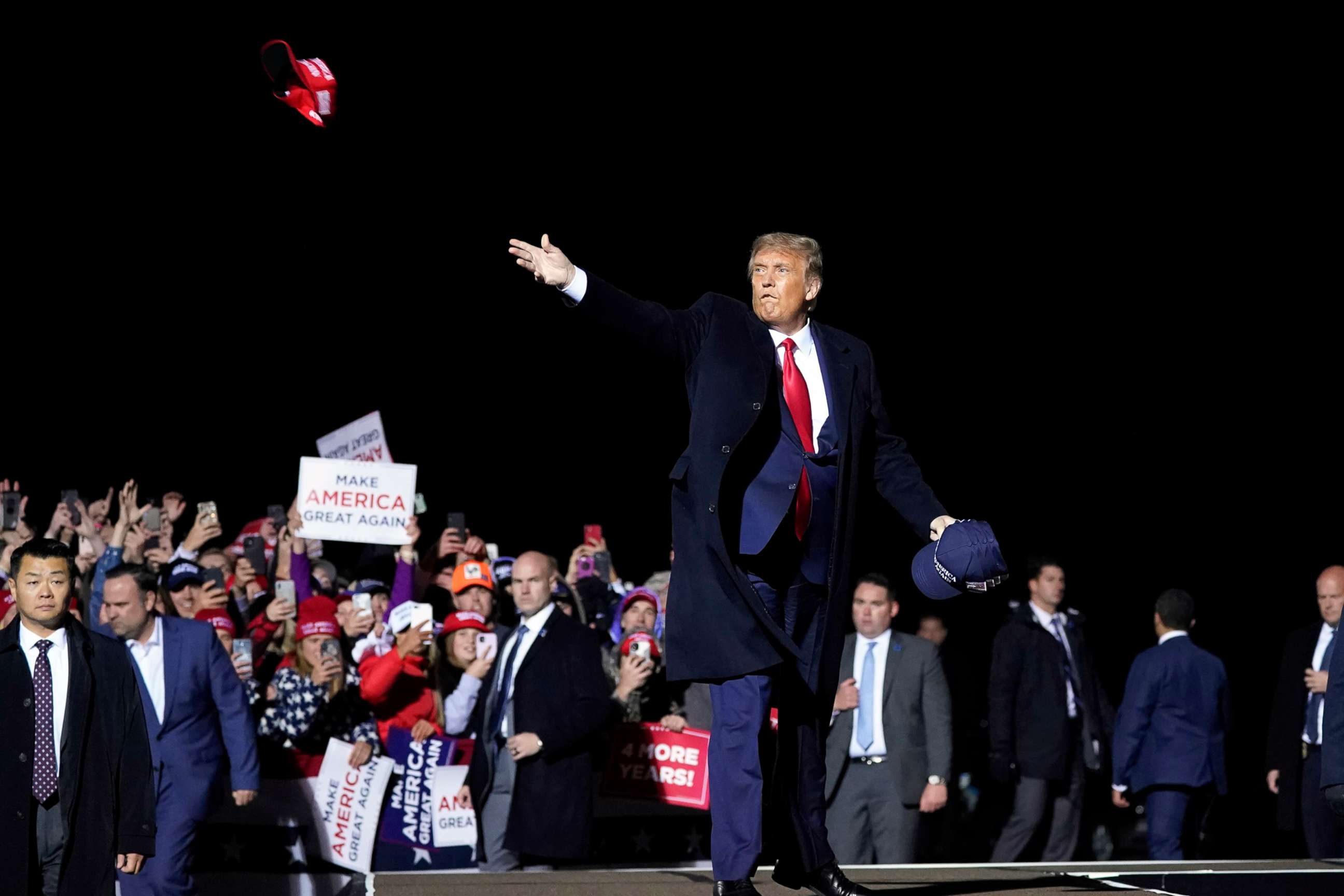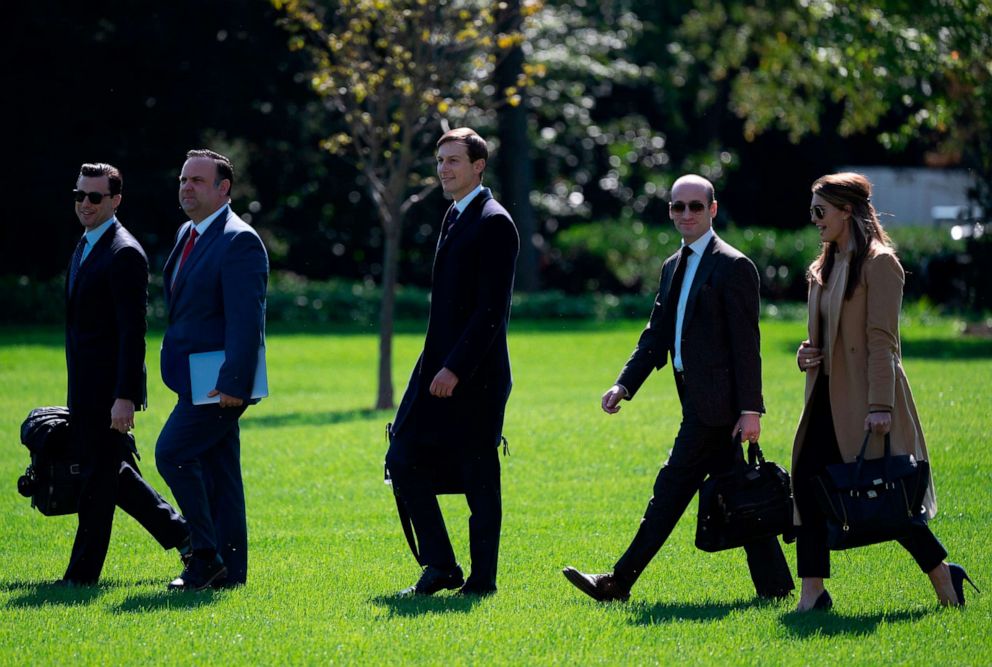Trump contracts coronavirus after downplaying risk for months. What next?
The news casts his health, his campaign and the U.S. government into disarray.
The news that President Donald Trump has tested positive for the COVID-19 -- after playing down the coronavirus threat for months -- raised serious concerns on Friday about the president’s health, the impact on his reelection campaign and most pressing -- questions about the running of the U.S. government.
Late Friday afternoon, as he was being taken to the hospital after his conditioned worsened, a senior administration official put out the word there would be no transfer of power.
"The president is in charge,” said White House Director of Strategic Communications Alyssa Farrah.
The day began with the stunning announcement of one of the gravest threats to a president's health in decades -- and to first lady Melania Trump who tested positive as well -- coming first not in an official announcement from the White House -- but from Trump himself in a trademark tweet.
At 12:54 a.m. Friday, the president confirmed he and the first lady had the virus and said they would “begin our quarantine and recovery process immediately.” He went on to express resolve that “We will get through this TOGETHER!”
At age 74, the president is considered to be in a high-risk category for severe illness from the virus.
Not long after Trump's tweet, White House physician Dr. Sean Conley said in a memorandum overnight that the president and first lady remained “well” and that he expected the president would “continue carrying out his duties without disruption.”

White House chief of staff Mark Meadows told reporters Friday morning that the president was having "mild symptoms" and was "not only in good spirits but very energetic."
On Friday afternoon, White House press secretary Kayleigh McEnany said Trump was "feeling good" but she declined to elaborate on his what she also described as "mild symptoms" or "exactly what type of tests" Trump has had.
Not long after, Conley put out another statement saying he did so "with the permission of President Donald J. Trump."
Following PCR-confirmation of the President’s diagnosis, as a precautionary measure he received a single 8 gram dose of Regeneron’s polyclonal antibody cocktail. He completed the infusion without incident. In addition to the polyclonal antibodies, the President has been taking zinc, vitamin D, famotidine, melatonin and a daily aspirin," the statement said.
"As of this afternoon the President remains fatigued but in good spirits. He’s being evaluated by a team of experts, and together we’ll be making recommendations to the President and First Lady in regards to next best steps," Conley said. "First Lady Melania Trump remains well with only a mild cough and headache, and the remainder of the First Family are well and tested negative for SARS-CoV-2 today."
There was no word on whether preparations were being made for any transfer of power to Vice President Mike Pence should Trump become incapacitated. A Pence spokesman said Friday morning that Pence and his wife tested negative for COVID-19 that morning. His physician later said in a statement that he does not need to quarantine and is "free to go about his normal activities."
In an assessment of the president’s overall health released earlier this year, Dr. Conley said the president "remains healthy.” But with a documented weight of 244 pounds, the president passed the official threshold of being considered obese. Health experts have said that obesity puts people at higher risk of a severe illness from COVID-19.
Because he is obese, he is three times more likely to be hospitalized than someone who is not obese, according to data from the Centers for Disease Control and Prevention. CDC data also shows that 74-year-olds are hospitalized five times more than 18 to 29 year olds, and the death rate for people of his age is 90 times higher compared to 18 to 29 year olds.!callout mobile=[false] url=[https://abcnews.go.com/US/president-trump-lady-test-positive-covid-19/story?id=73380448] text=[MORE: Trump COVID updates: President, first lady test positive for coronavirus]/>

The president became a pandemic statistic himself a little more than a month left before Election Day and as many across the country have already begun casting their votes amid a public health crisis that has claimed over 200,000 American lives.
Word of the president’s own diagnosis came just hours after the country learned via a news leak that Hope Hicks, one of the president’s closest aides, had also contracted the virus. The president confirmed the news of Hicks in an interview with Fox News's Sean Hannity and revealed that he and the first lady were awaiting test results.
“She tested positive. And I just went out with a test. I'll see what -- because we spend a lot of time. And the first lady just went out with a test also. So, whether we quarantine, or whether we have it, I don't know,” Trump told Hannity.

Hicks was with the president just one day earlier on Wednesday when he traveled to Minnesota for a campaign fundraiser and rally. On that trip, Hicks was in close proximity to the president, traveling with him aboard the presidential helicopter and plane. She was photographed not wearing a mask.
Her getting sick and the president’s positive results also raised questions about how many members of the White House staff and others who the president with whom the president had been in contact would be affected.
President Trump has maintained a busy campaign schedule this week, speaking at multiple rallies at which thousands of the president’s fans have assembled outside and in open-air airplane hangars, many without masks, to hear the president speak.
He also participated Tuesday night in the first general election debate in Cleveland, sharing the stage with his Democratic opponent and former Vice President Joe Biden. The candidates did not shake hands and were spaced more than 6 feet apart from one another on the stage, but there are now questions about whether Biden was also exposed to the virus.
Members of the president's entourage prepared for the debate at a hotel a few blocks away from the debate site. Chief of Staff Meadows, as well as the president's son Eric and his wife Lara, did not wear masks as they walked through the lobby. Neither did Trump's senior adviser and son-in-law Jared Kushner nor his campaign manager Bill Stepien.
The president, who has eschewed wearing a face mask throughout the pandemic despite the advice of his administration’s top experts that the general public do so, has mocked Biden for doing so.
“I don't wear masks like him. Every time you see him, he's got a mask. He could be speaking 200 feet away from it, and he shows up with the biggest mask I've seen,” Trump said at Tuesday night’s debate and bragged about the large showings for his outdoor rallies.
Asked if he had concerns about the virus spreading at his rallies, Trump said, “Well, so far, we've had no problem whatsoever. It's outside, that’s a big difference. According to the experts. We do them outside. We have tremendous crowds as you see, I mean, every -- and literally, on 24 hours notice. And Joe does the circles and has three people some place.”
It was unclear when Trump and Pence were last together. The vice president said Tuesday he had spent time with the president in the Oval Office that day, and a day before they appeared together at a news conference.
On Tuesday, Pence visited the Capitol with Trump's nominee for the Supreme Court, Judge Amy Coney Barrett, accompanying her for a meeting with Senate Majority Leader Mitch McConnell.
The White House has strenuous testing protocols in place designed to insulate the president from the virus. The president is tested on a regular basis and those who come into close contact with him get tested on a daily basis.
Officials have cited a rigorous testing program in justifying the president’s decision to forego a mask, as he usually does except in rare settings like hospitals. Most of the president’s aides at the White House do not wear masks while at work.
Even before Hicks' diagnosis, several people in the president’s orbit had caught the virus in months’ prior.
Back in May, Vice President Pence’s communications director, Katie Miller, who is married to White House senior adviser Stephen Miller, became the first known senior member of the White House staff to test positive for the virus.
Kimberly Guilfoyle, who is in a romantic relationship with the President Trump’s eldest son Donald Trump Jr. and also works for the campaign, tested positive in July. So too did National Security Adviser Robert O’Brien.
Herman Cain, a political ally of the president’s and a former presidential candidate, was hospitalized 11 days after he attended President Donald Trump's indoor rally in Tulsa, Oklahoma, on June 20 and later died.
ABC News' John Santucci, Dr. Alexis Carrington, Ben Gittleson and Benjamin Siegel contributed to this report.



